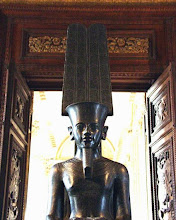More Nefertiti
This article is from Al-Ahram and written by Zahi Hawass, a leading figure in Egypt regarding Egyptological matters. The photo of the mentioned mummy wasn't in the article so i added it (image 1) myself. Interesting is that there was also a mummy (image 2)called "The Elder Woman". Hair from her was found in Tutankamun's tomb. There seemed to have been a family relationship between the two so it was claimed she was Queen Tiye who was Tutankhamun's grandmother. Only one problem the mummy is too young to be Tiye. And now the question i wonder and has not been investigated. Can it be Ankhesenamun, Tutankhamun's half-sister and wife? That would be a find!
"When I was conducting the CT scan on the mummy of Tutankhamun in the Valley of the Kings in 2005, I thought I would take the opportunity to scan all the unidentified mummies in the valley.
Three mummies are located in the tomb of Amenhotep II (KV 35). Scholars have differing opinions concerning the identities of these mummies, but one in particular was the star of the media over the past three years. A CT scan was taken of it; this, which essentially goes inside the mummy and captures approximately 1,700 images. The British archaeologist Joann Fletcher identified it as Queen Nefertiti. The CT scan of this mummy was studied by Ashraf Selim, professor of radiology in the Faculty of Medicine at Cairo University. Recently, Brando Quicili made a new film about Nefertiti for National Geographic. This film was intended to uncover the real facts behind the most famous queen of Egypt. Abbie Harper was also enthusiastic to present all the evidence cited by Fletcher in the Discovery Channel film and also what has been written about the famous Egyptian queen.
Now, it is time to present the evidence that we have discovered from the study of the CT scan, which will prove that the younger lady discovered in KV 35 cannot be Nefertiti. The principal piece of evidence that Fletcher used in her identification was to match the disarticulated "bent royal arm" (the one which lies at the mummy's feet) with the body. She claimed that this disarticulated forearm with its clenched fist, found amongst the wrappings, was the arm that belonged to the mummy. Her evidence was based on the straight right arm, found lying beside the body, which was "too long". Also, the bone density was different from the attached left arm, whereas the bone density of the royal forearm was more similar. Furthermore, she used the bent right arm and not the left as evidence that it wasn't "Nefertiti" but it was in fact the Pharaoh Smenkhare. She offered no suggestions as to why only the forearm was found, and not the complete arm.
However, the radiologists could more accurately measure the dimensions of both disarticulated arms from the new CT scan. They discovered that, in fact, the straight arm was almost exactly the same length as the attached left arm, whereas the royal forearm was somewhat shorter. They also explained that the probable reason why Fletcher had assumed the straight arm was too long was that she had not taken into account the gap left by the fracture in the upper right arm. Once this gap was subtracted, the total length of the right arm is the same as the attached left arm. The radiologists also found that there was practically no difference in the bone density of the straight arm and the attached arm.
Fletcher also suggested that the facial trauma to the mummy was caused through malice and occurred post-mortem, which is evidence of the hatred felt towards Nefertiti. Other members of Fletcher's team suggested that the trauma could be pre- mortem but this was not really explained or confirmed by them. However, the CT scan study indicated that the trauma to the left cheek was almost certainly post-mortem, and definitely occurred before embalming.
The evidence introduced by the CT scan concluded that this mummy was, therefore, almost certainly not a royal mummy of a queen, although she could have been a princess. The mummy was therefore unlikely to be Nefertiti."
Source






